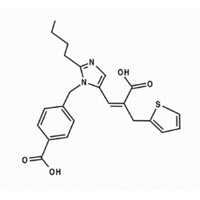Jong P, Demers C, McKelvie RS, Liu PP, Angiotensin receptor blockers in heart failure: meta-analysis of randomized controlled trials. J Am Coll Cardiol 2002; 39:463-70.
* BACKGROUND Although, in theory, angiotensin receptor blockers (ARBs) offer improved blockade of the renin-angiotensin-aldosterone pathway over angiotensin-converting enzyme (ACE) inhibitors, their relative effectiveness in the treatment of heart failure remains controversial. This meta-analysis combined all relevant randomized-controlled studies comparing the benefits of ARBs alone or in combination with ACE inhibitors.
* POPULATION STUDIED The authors identified 17 studies comparing ARBs with placebo or ACE inhibitors published before May 2001 through a search of 7 relevant databases. To be included, the studies had to have a treatment duration of at least 4 weeks, include patients with New York Heart Association functional class II to IV, use a randomized, blinded design, and report outcomes of death or hospitalization. Studies were excluded if they were published only as abstracts or in non-peer-reviewed journals, were crossover trials or single-dose studies, included nonrandomized investigational agents, or had other significant validity concerns. Three ongoing, but otherwise relevant, studies were not included.
The 17 trials included a total of 12,469 patients whose mean ages ranged from 56 to 73 years. The trials included 48% to 100% men and 59% to 100% white patients. The proportion of patients with severe heart failure (class IV) varied from 2% to 15% across the studies.
Seven studies compared ARBs with placebo, and 1 included only ACE inhibitor-intolerant patients. Six studies compared ARBs with ACE inhibitors and 6 compared ARBs plus ACE inhibitors with ACE inhibitors alone (2 trials contained 2 arms). Five different ARBs were used: losartan (9 studies), candesartan (3 studies), valsartan (3 studies), irbesartan (1 study), and eprosartan (1 study). The length of treatment varied from 4 weeks to 1.5 years.
* STUDY DESIGN AND VALIDITY The protocol followed guidelines for performing Cochrane reviews. Inclusion decisions were reached by consensus and outcome data were independently extracted by 2 reviewers, with disagreements settled by consensus or third reviewer. Reasons fur excluding each article were listed and potential validity concerns of the included articles were addressed. For their primary analysis the authors combined all ARBs regardless of type, dosage, or concomitant ACE inhibitor therapy and compared them with all controls, whether placebo or ACE inhibitors. Subanalyses followed comparing ARBs with placebo, ACE inhibitors, and ARB + ACE inhibitor with ACE inhibitor alone. All data were analyzed based on intention to treat.
This well-done meta-analysis is a valid summary of the current evidence. However, with 3 major ongoing trials, the conclusions may change in the future. The conclusions are limited by assuming a class effect of all ARBs and ACE inhibitors and not evaluating the outcomes with different dosages. In addition, the authors reported a post hoc power calculation for the primary analysis only, making the nonsignificant findings of the subanalyses difficult to interpret.
* OUTCOMES MEASURED The primary outcome was all-cause mortality (evaluated in all 17 trials). The secondary outcome was hospitalization for heart failure, worsening signs and symptoms of heart failure, or complications of heart failure treatment. Hospitalization data were extractable from only 6 of the trials, but these trials contained the most patients (N = 10,031).
* RESULTS No statistical difference in all-cause mortality was found in the primary analysis (odds ratio [OR] = 0.96; 95% confidence interval [CI], 0.75-1.23). There was also no difference in mortality in trials comparing ARBs with placebo only (OR = 0.68; 95% CI, 0.38-1.22), trials comparing ARBs with ACE inhibitors (OR = 1.09: 95% CI, 0.92-1.29), or in trials comparing combined ARBs and ACE inhibitors with ACE inhibitors alone (OR = 1.04; 95% CI, 0.91-1.20). Overall, treatment with an ARB had no affect on the rate of hospitalization due to heart failure. Similar to mortality, 2 of the subanalyses, ARBs vs placebo and ARBs vs ACE inhibitors, showed no difference (OR = 0.67; 95% CI, 0.29-1.51 and OR = 0.95; 95% CI, 0.80-1.13). However, the combination of ARBs with ACE inhibitors reduced hospitalization rates as compared with ACE inhibitors alone (OR = 0.74: 95% CI, 0.64-0.86, NNT = 23 for about 2 years).
RECOMMENDATIONS FOR CLINICAL PRACTICE
This meta-analysis, combining all relevant trials to date, did not demonstrate a reduction in mortality in patients treated with ARBs for heart failure. Despite this finding, patients unable to take an ACE inhibitor may still receive a benefit if an ARB is substituted. The combination of an ACE inhibitor and an ARB may decrease the overall rate of hospitalization for worsening heart failure, but not mortality. However, studies with dose-adjusted comparisons are required before justifying the added costs and risks associated with combining both medications. Meanwhile, clinicians should continue to use ACE inhibitors as first-line therapy in heart failure and consider ARBs for patients unable to tolerate ACE inhibitors.
COPYRIGHT 2002 Appleton & Lange
COPYRIGHT 2002 Gale Group



